Ethical Dilemmas: Navigating Business Ethics and Cross-Cultural Issues
VerifiedAdded on 2023/06/12
|7
|1321
|176
Essay
AI Summary
This essay explores the intersection of ethical issues and culture in business, focusing on how cross-cultural dynamics can create ethical dilemmas. It introduces key business ethics principles and highlights the importance of equity, trust, and responsibility in business operations. The essay discusses common ethical challenges such as working conditions, workplace diversity, harassment, and environmental concerns. It utilizes Hofstede's cultural dimensions theory to understand cultural differences across countries, examining individualism vs. collectivism, power distance, masculinity vs. femininity, uncertainty avoidance, and long-term vs. short-term orientation. The essay suggests approaches to resolve ethical dilemmas, including refuting the dilemma and applying value theory. It concludes by emphasizing the need for organizations to establish a strong ethical foundation, implement effective policies, and foster a culture of integrity to navigate cross-cultural challenges successfully. Desklib provides students access to similar essays and study resources.
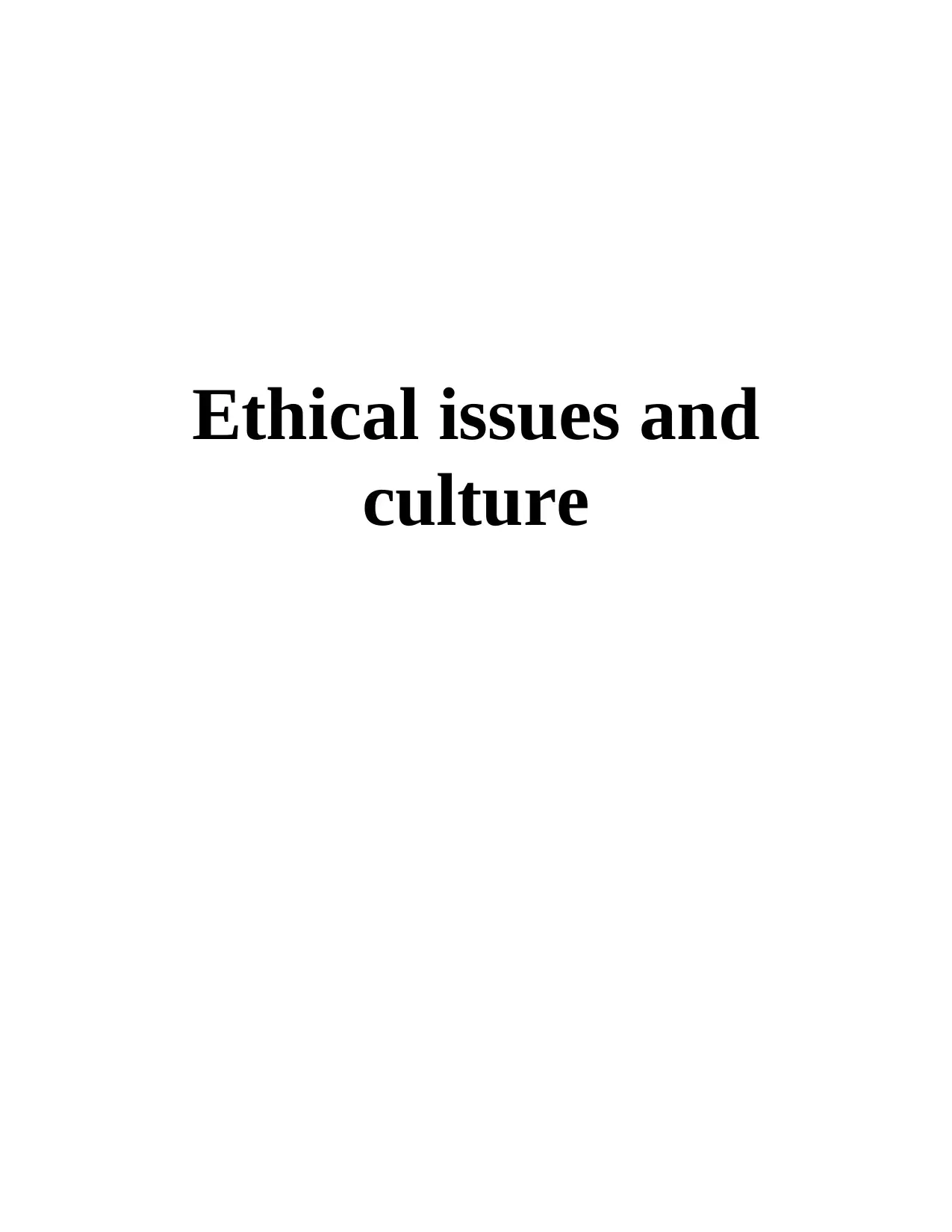
Ethical issues and
culture
culture
Paraphrase This Document
Need a fresh take? Get an instant paraphrase of this document with our AI Paraphraser
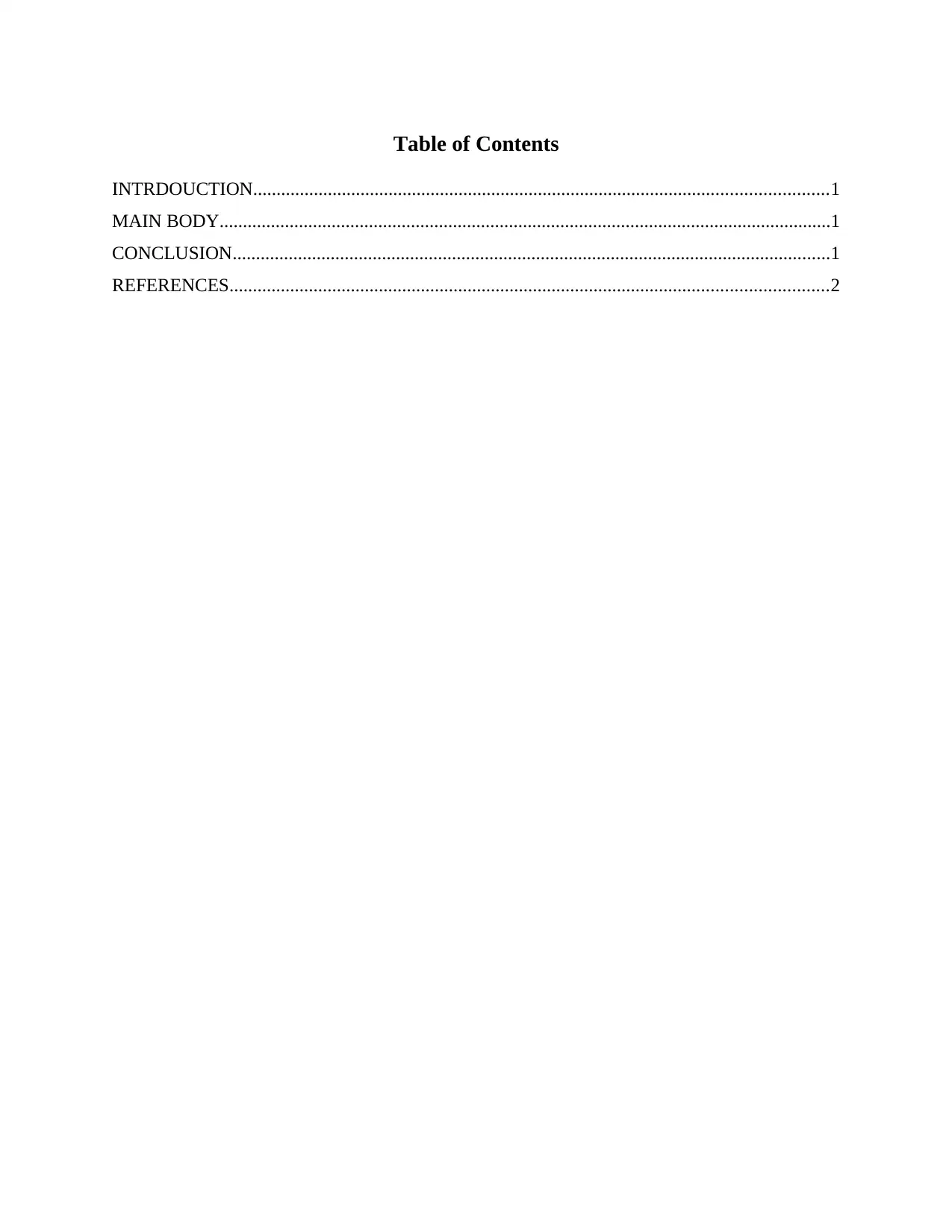
Table of Contents
INTRDOUCTION...........................................................................................................................1
MAIN BODY...................................................................................................................................1
CONCLUSION................................................................................................................................1
REFERENCES................................................................................................................................2
INTRDOUCTION...........................................................................................................................1
MAIN BODY...................................................................................................................................1
CONCLUSION................................................................................................................................1
REFERENCES................................................................................................................................2
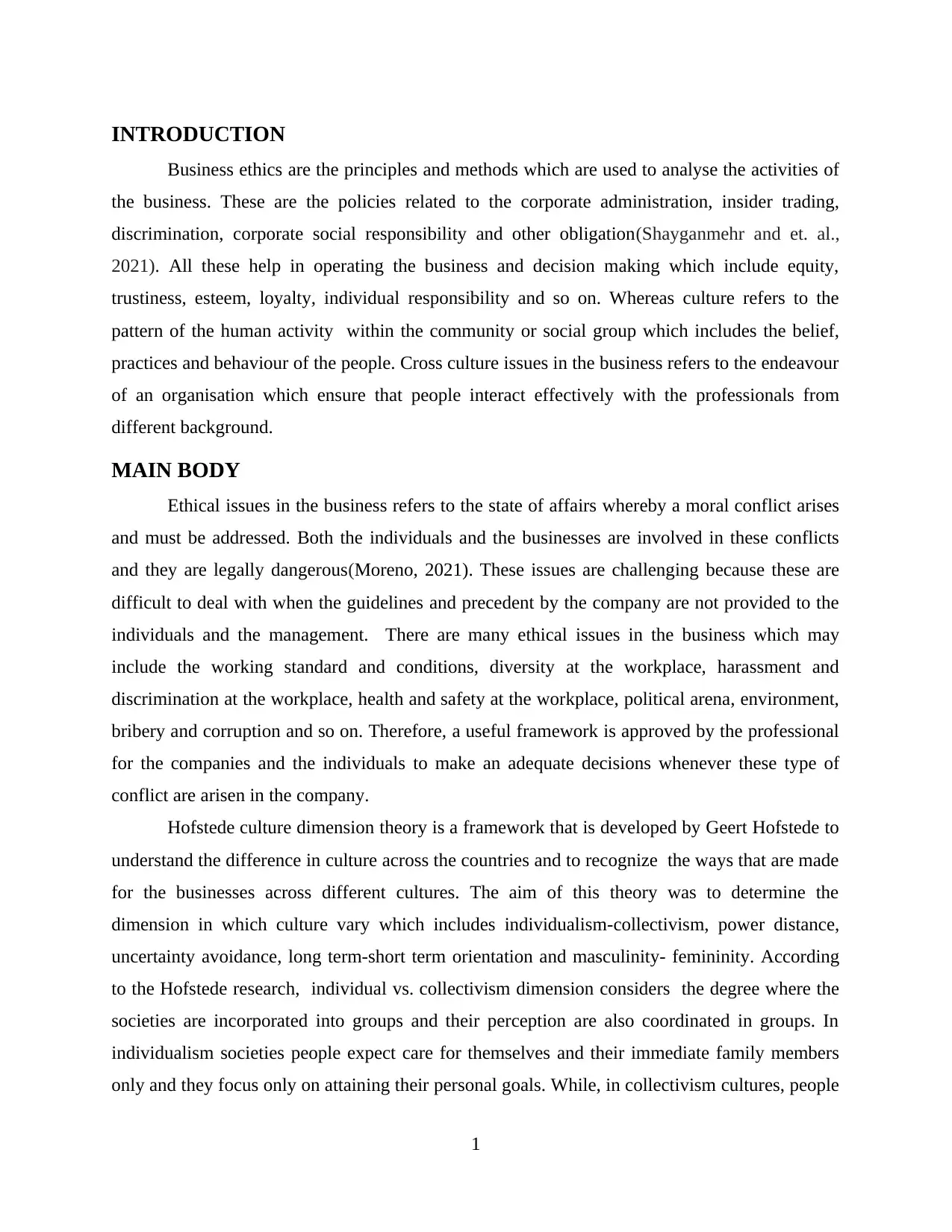
INTRODUCTION
Business ethics are the principles and methods which are used to analyse the activities of
the business. These are the policies related to the corporate administration, insider trading,
discrimination, corporate social responsibility and other obligation(Shayganmehr and et. al.,
2021). All these help in operating the business and decision making which include equity,
trustiness, esteem, loyalty, individual responsibility and so on. Whereas culture refers to the
pattern of the human activity within the community or social group which includes the belief,
practices and behaviour of the people. Cross culture issues in the business refers to the endeavour
of an organisation which ensure that people interact effectively with the professionals from
different background.
MAIN BODY
Ethical issues in the business refers to the state of affairs whereby a moral conflict arises
and must be addressed. Both the individuals and the businesses are involved in these conflicts
and they are legally dangerous(Moreno, 2021). These issues are challenging because these are
difficult to deal with when the guidelines and precedent by the company are not provided to the
individuals and the management. There are many ethical issues in the business which may
include the working standard and conditions, diversity at the workplace, harassment and
discrimination at the workplace, health and safety at the workplace, political arena, environment,
bribery and corruption and so on. Therefore, a useful framework is approved by the professional
for the companies and the individuals to make an adequate decisions whenever these type of
conflict are arisen in the company.
Hofstede culture dimension theory is a framework that is developed by Geert Hofstede to
understand the difference in culture across the countries and to recognize the ways that are made
for the businesses across different cultures. The aim of this theory was to determine the
dimension in which culture vary which includes individualism-collectivism, power distance,
uncertainty avoidance, long term-short term orientation and masculinity- femininity. According
to the Hofstede research, individual vs. collectivism dimension considers the degree where the
societies are incorporated into groups and their perception are also coordinated in groups. In
individualism societies people expect care for themselves and their immediate family members
only and they focus only on attaining their personal goals. While, in collectivism cultures, people
1
Business ethics are the principles and methods which are used to analyse the activities of
the business. These are the policies related to the corporate administration, insider trading,
discrimination, corporate social responsibility and other obligation(Shayganmehr and et. al.,
2021). All these help in operating the business and decision making which include equity,
trustiness, esteem, loyalty, individual responsibility and so on. Whereas culture refers to the
pattern of the human activity within the community or social group which includes the belief,
practices and behaviour of the people. Cross culture issues in the business refers to the endeavour
of an organisation which ensure that people interact effectively with the professionals from
different background.
MAIN BODY
Ethical issues in the business refers to the state of affairs whereby a moral conflict arises
and must be addressed. Both the individuals and the businesses are involved in these conflicts
and they are legally dangerous(Moreno, 2021). These issues are challenging because these are
difficult to deal with when the guidelines and precedent by the company are not provided to the
individuals and the management. There are many ethical issues in the business which may
include the working standard and conditions, diversity at the workplace, harassment and
discrimination at the workplace, health and safety at the workplace, political arena, environment,
bribery and corruption and so on. Therefore, a useful framework is approved by the professional
for the companies and the individuals to make an adequate decisions whenever these type of
conflict are arisen in the company.
Hofstede culture dimension theory is a framework that is developed by Geert Hofstede to
understand the difference in culture across the countries and to recognize the ways that are made
for the businesses across different cultures. The aim of this theory was to determine the
dimension in which culture vary which includes individualism-collectivism, power distance,
uncertainty avoidance, long term-short term orientation and masculinity- femininity. According
to the Hofstede research, individual vs. collectivism dimension considers the degree where the
societies are incorporated into groups and their perception are also coordinated in groups. In
individualism societies people expect care for themselves and their immediate family members
only and they focus only on attaining their personal goals. While, in collectivism cultures, people
1
⊘ This is a preview!⊘
Do you want full access?
Subscribe today to unlock all pages.

Trusted by 1+ million students worldwide
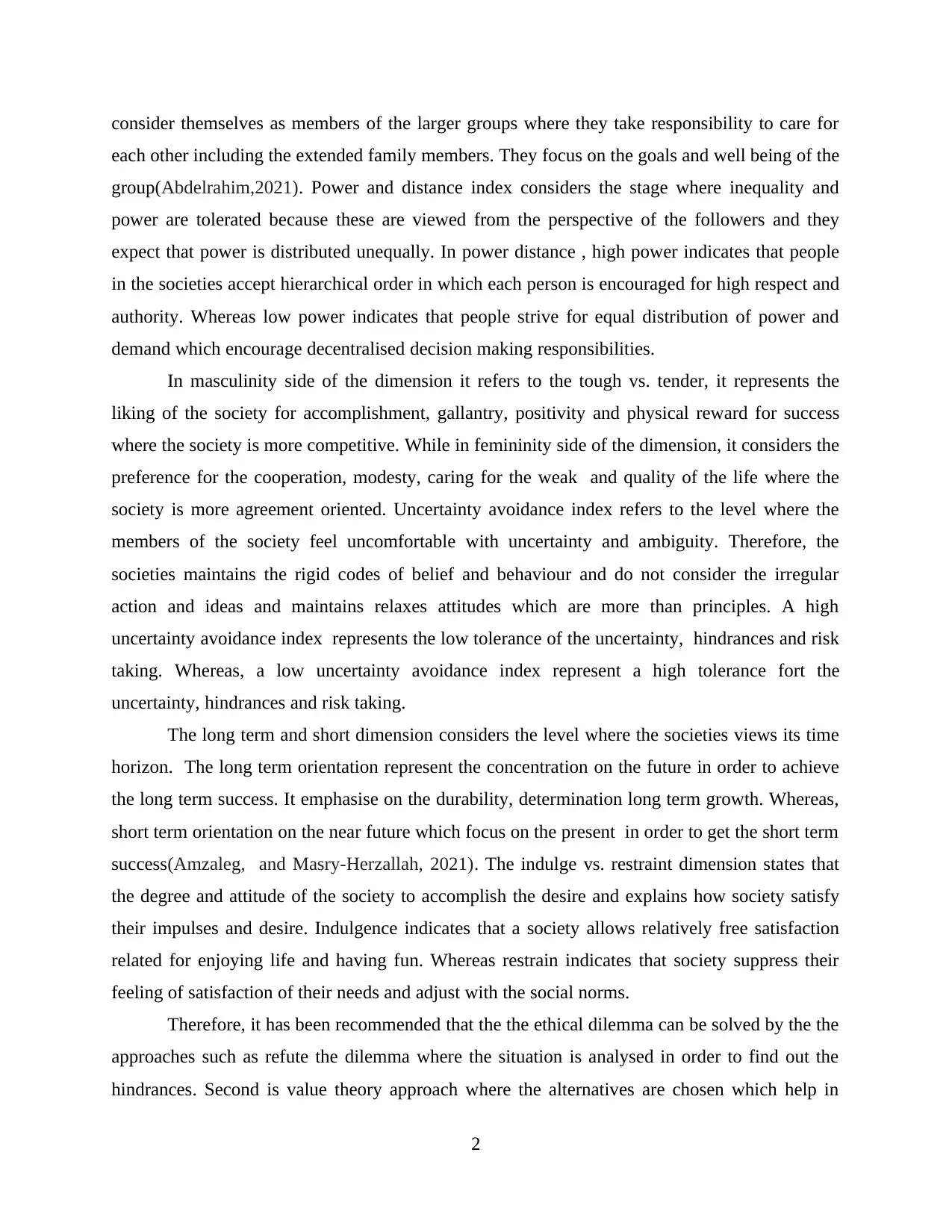
consider themselves as members of the larger groups where they take responsibility to care for
each other including the extended family members. They focus on the goals and well being of the
group(Abdelrahim,2021). Power and distance index considers the stage where inequality and
power are tolerated because these are viewed from the perspective of the followers and they
expect that power is distributed unequally. In power distance , high power indicates that people
in the societies accept hierarchical order in which each person is encouraged for high respect and
authority. Whereas low power indicates that people strive for equal distribution of power and
demand which encourage decentralised decision making responsibilities.
In masculinity side of the dimension it refers to the tough vs. tender, it represents the
liking of the society for accomplishment, gallantry, positivity and physical reward for success
where the society is more competitive. While in femininity side of the dimension, it considers the
preference for the cooperation, modesty, caring for the weak and quality of the life where the
society is more agreement oriented. Uncertainty avoidance index refers to the level where the
members of the society feel uncomfortable with uncertainty and ambiguity. Therefore, the
societies maintains the rigid codes of belief and behaviour and do not consider the irregular
action and ideas and maintains relaxes attitudes which are more than principles. A high
uncertainty avoidance index represents the low tolerance of the uncertainty, hindrances and risk
taking. Whereas, a low uncertainty avoidance index represent a high tolerance fort the
uncertainty, hindrances and risk taking.
The long term and short dimension considers the level where the societies views its time
horizon. The long term orientation represent the concentration on the future in order to achieve
the long term success. It emphasise on the durability, determination long term growth. Whereas,
short term orientation on the near future which focus on the present in order to get the short term
success(Amzaleg, and Masry-Herzallah, 2021). The indulge vs. restraint dimension states that
the degree and attitude of the society to accomplish the desire and explains how society satisfy
their impulses and desire. Indulgence indicates that a society allows relatively free satisfaction
related for enjoying life and having fun. Whereas restrain indicates that society suppress their
feeling of satisfaction of their needs and adjust with the social norms.
Therefore, it has been recommended that the the ethical dilemma can be solved by the the
approaches such as refute the dilemma where the situation is analysed in order to find out the
hindrances. Second is value theory approach where the alternatives are chosen which help in
2
each other including the extended family members. They focus on the goals and well being of the
group(Abdelrahim,2021). Power and distance index considers the stage where inequality and
power are tolerated because these are viewed from the perspective of the followers and they
expect that power is distributed unequally. In power distance , high power indicates that people
in the societies accept hierarchical order in which each person is encouraged for high respect and
authority. Whereas low power indicates that people strive for equal distribution of power and
demand which encourage decentralised decision making responsibilities.
In masculinity side of the dimension it refers to the tough vs. tender, it represents the
liking of the society for accomplishment, gallantry, positivity and physical reward for success
where the society is more competitive. While in femininity side of the dimension, it considers the
preference for the cooperation, modesty, caring for the weak and quality of the life where the
society is more agreement oriented. Uncertainty avoidance index refers to the level where the
members of the society feel uncomfortable with uncertainty and ambiguity. Therefore, the
societies maintains the rigid codes of belief and behaviour and do not consider the irregular
action and ideas and maintains relaxes attitudes which are more than principles. A high
uncertainty avoidance index represents the low tolerance of the uncertainty, hindrances and risk
taking. Whereas, a low uncertainty avoidance index represent a high tolerance fort the
uncertainty, hindrances and risk taking.
The long term and short dimension considers the level where the societies views its time
horizon. The long term orientation represent the concentration on the future in order to achieve
the long term success. It emphasise on the durability, determination long term growth. Whereas,
short term orientation on the near future which focus on the present in order to get the short term
success(Amzaleg, and Masry-Herzallah, 2021). The indulge vs. restraint dimension states that
the degree and attitude of the society to accomplish the desire and explains how society satisfy
their impulses and desire. Indulgence indicates that a society allows relatively free satisfaction
related for enjoying life and having fun. Whereas restrain indicates that society suppress their
feeling of satisfaction of their needs and adjust with the social norms.
Therefore, it has been recommended that the the ethical dilemma can be solved by the the
approaches such as refute the dilemma where the situation is analysed in order to find out the
hindrances. Second is value theory approach where the alternatives are chosen which help in
2
Paraphrase This Document
Need a fresh take? Get an instant paraphrase of this document with our AI Paraphraser
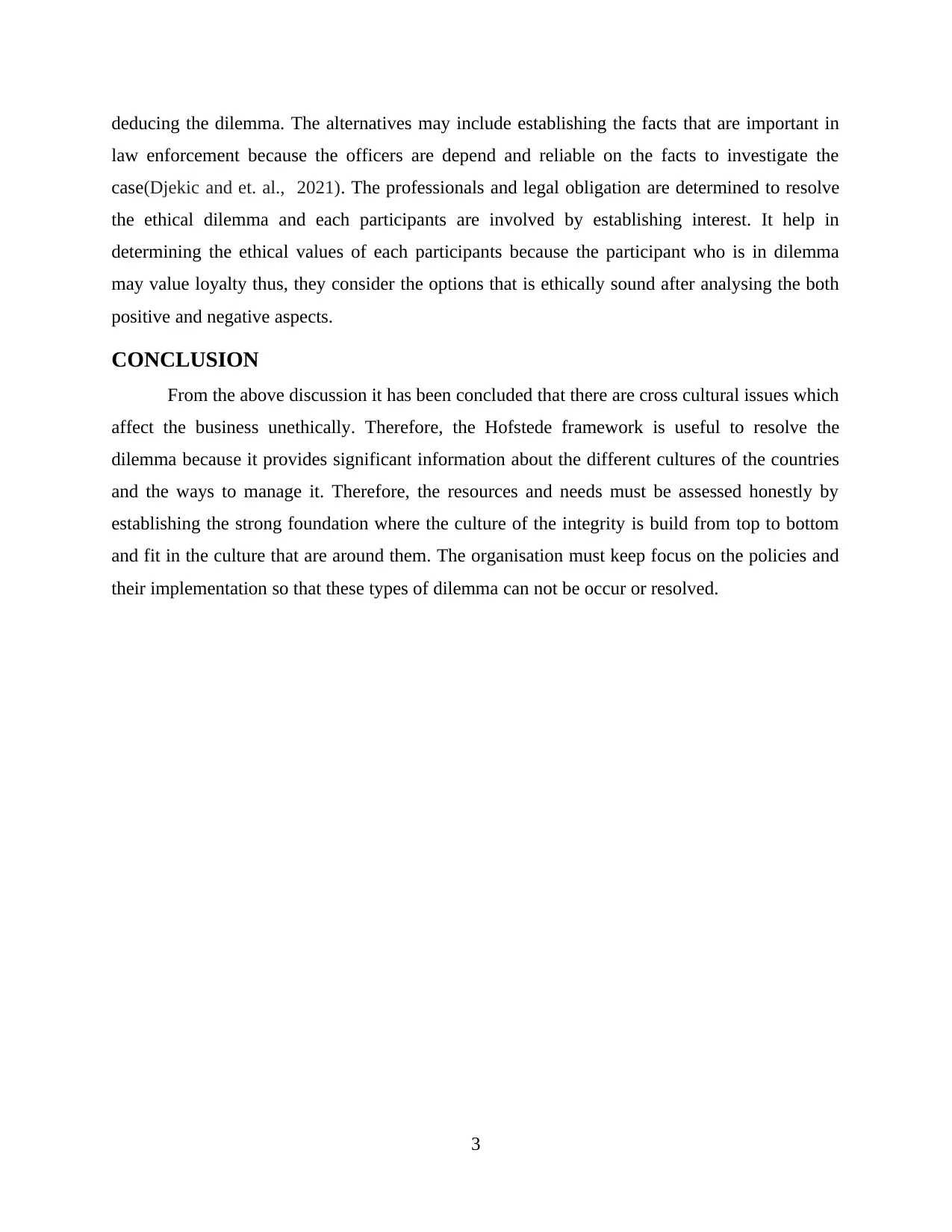
deducing the dilemma. The alternatives may include establishing the facts that are important in
law enforcement because the officers are depend and reliable on the facts to investigate the
case(Djekic and et. al., 2021). The professionals and legal obligation are determined to resolve
the ethical dilemma and each participants are involved by establishing interest. It help in
determining the ethical values of each participants because the participant who is in dilemma
may value loyalty thus, they consider the options that is ethically sound after analysing the both
positive and negative aspects.
CONCLUSION
From the above discussion it has been concluded that there are cross cultural issues which
affect the business unethically. Therefore, the Hofstede framework is useful to resolve the
dilemma because it provides significant information about the different cultures of the countries
and the ways to manage it. Therefore, the resources and needs must be assessed honestly by
establishing the strong foundation where the culture of the integrity is build from top to bottom
and fit in the culture that are around them. The organisation must keep focus on the policies and
their implementation so that these types of dilemma can not be occur or resolved.
3
law enforcement because the officers are depend and reliable on the facts to investigate the
case(Djekic and et. al., 2021). The professionals and legal obligation are determined to resolve
the ethical dilemma and each participants are involved by establishing interest. It help in
determining the ethical values of each participants because the participant who is in dilemma
may value loyalty thus, they consider the options that is ethically sound after analysing the both
positive and negative aspects.
CONCLUSION
From the above discussion it has been concluded that there are cross cultural issues which
affect the business unethically. Therefore, the Hofstede framework is useful to resolve the
dilemma because it provides significant information about the different cultures of the countries
and the ways to manage it. Therefore, the resources and needs must be assessed honestly by
establishing the strong foundation where the culture of the integrity is build from top to bottom
and fit in the culture that are around them. The organisation must keep focus on the policies and
their implementation so that these types of dilemma can not be occur or resolved.
3
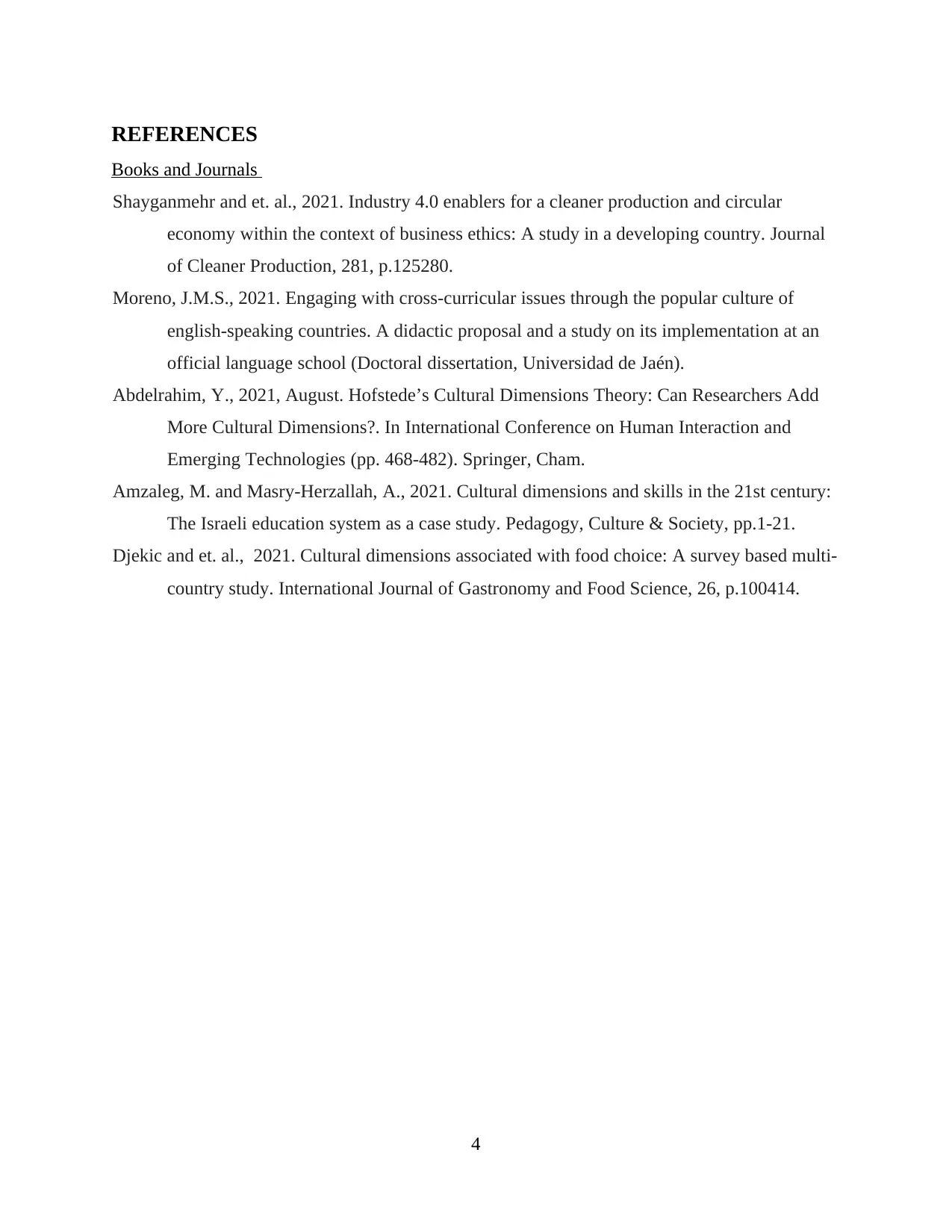
REFERENCES
Books and Journals
Shayganmehr and et. al., 2021. Industry 4.0 enablers for a cleaner production and circular
economy within the context of business ethics: A study in a developing country. Journal
of Cleaner Production, 281, p.125280.
Moreno, J.M.S., 2021. Engaging with cross-curricular issues through the popular culture of
english-speaking countries. A didactic proposal and a study on its implementation at an
official language school (Doctoral dissertation, Universidad de Jaén).
Abdelrahim, Y., 2021, August. Hofstede’s Cultural Dimensions Theory: Can Researchers Add
More Cultural Dimensions?. In International Conference on Human Interaction and
Emerging Technologies (pp. 468-482). Springer, Cham.
Amzaleg, M. and Masry-Herzallah, A., 2021. Cultural dimensions and skills in the 21st century:
The Israeli education system as a case study. Pedagogy, Culture & Society, pp.1-21.
Djekic and et. al., 2021. Cultural dimensions associated with food choice: A survey based multi-
country study. International Journal of Gastronomy and Food Science, 26, p.100414.
4
Books and Journals
Shayganmehr and et. al., 2021. Industry 4.0 enablers for a cleaner production and circular
economy within the context of business ethics: A study in a developing country. Journal
of Cleaner Production, 281, p.125280.
Moreno, J.M.S., 2021. Engaging with cross-curricular issues through the popular culture of
english-speaking countries. A didactic proposal and a study on its implementation at an
official language school (Doctoral dissertation, Universidad de Jaén).
Abdelrahim, Y., 2021, August. Hofstede’s Cultural Dimensions Theory: Can Researchers Add
More Cultural Dimensions?. In International Conference on Human Interaction and
Emerging Technologies (pp. 468-482). Springer, Cham.
Amzaleg, M. and Masry-Herzallah, A., 2021. Cultural dimensions and skills in the 21st century:
The Israeli education system as a case study. Pedagogy, Culture & Society, pp.1-21.
Djekic and et. al., 2021. Cultural dimensions associated with food choice: A survey based multi-
country study. International Journal of Gastronomy and Food Science, 26, p.100414.
4
⊘ This is a preview!⊘
Do you want full access?
Subscribe today to unlock all pages.

Trusted by 1+ million students worldwide

5
1 out of 7
Related Documents
Your All-in-One AI-Powered Toolkit for Academic Success.
+13062052269
info@desklib.com
Available 24*7 on WhatsApp / Email
![[object Object]](/_next/static/media/star-bottom.7253800d.svg)
Unlock your academic potential
Copyright © 2020–2025 A2Z Services. All Rights Reserved. Developed and managed by ZUCOL.




